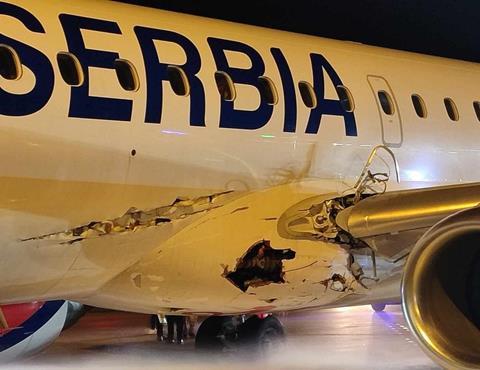Pilots of an Embraer 195 that hit lighting structures on take-off from Belgrade had been warned to check they still had sufficient runway to depart, after lining up at a different intersection than planned, Serbian investigators have disclosed.
The Marathon Airlines twinjet – with 106 passengers and five crew members – had been operating an Air Serbia service to Dusseldorf on 18 February.
Serbian traffic investigation authority CINS states that the crew had calculated take-off parameters for a runway 30L departure from intersection D6. The Serbian aeronautical information publication gives the distance available from D6 as 2,349m.
CINS says the crew testified that the take-off calculation was “double-checked”.
The aircraft was instructed by air traffic control to proceed to intersection D6 via taxiways F, G and A which the crew correctly read back. This taxiing direction would have taken the aircraft past intersection D5 before reaching D6.
But while the crew informed the tower, at 17:35, that they were approaching D6 and were ready for take-off, CINS says the tower controller transmitted an “urgent message” about a minute later, asking if they were aware that they had taken the turning for D5.
The controller pointed out that the available runway length from D5 was only 1,273m and suggested this was not sufficient.
CINS says the crew requested a few moments to carry out checks. The crew subsequently testified that the take-off parameters were checked with the first officer’s handheld tablet.
Although the controller had told the crew that, if necessary, they could backtrack to intersection D6, the crew responded some 30s later that they had confirmed the aircraft could take off. After reconfirming with the crew, the controller gave clearance for a D5 intersection take-off, informing the crew that there was no wind.

The aircraft commenced its take-off roll at 17:38. Its crew ascertained, at 80kt, that the take-off was proceeding normally but, at 100kt, realised that the runway end was approaching.
CINS says the pilots decided the safer course was to continue the take-off, given the aircraft’s speed, and opted to use maximum thrust while delaying rotation in order to use all the available runway.
Tower controllers observed the aircraft become airborne with a “cloud of dust behind” and a “weak climb”, states the inquiry.
Its crew felt the aircraft shake and then heard an impact with an object, after which they began receiving alerts about a number of systems – notably the flaps and bleed air – and started running checklists.
The controller noticed that the aircraft was deviating from its approved course, and asked the crew whether anything was wrong, to which the pilots replied that they would probably need to return to the airport because they had hit something on the ground.
In order to perform checks, and determine the parts of the aircraft affected, the crew carried out two circuits southeast of the airport, and then sought to conduct a low pass in the direction of runway 30L, with the landing-gear extended, for a visual assessment by the tower controllers.
While no problem with the undercarriage could be seen, the crew experienced flap problems and vibrations during the descent but landed safely – at a slightly higher-than-normal speed, but within limits – on 30L at 18:36.
The aircraft taxied to a parking bay and the passengers disembarked through an airbridge while firefighters used foam to deal with a fuel leak from the left wing.
None of the occupants was injured.
Inspection of the far end of runway 30L indicated that the aircraft’s nose-wheel had lifted at the end of the runway, but its main wheels had overrun onto rough ground, transmitting vibrations through the airframe.
The nose-wheel hit control boxes for the runway 12R approach lights, while the fuselage and left wing root ploughed through an ILS antenna support – a relatively strong steel structure – causing substantial damage to the aircraft, and leaving parts of the antenna embedded in the jet’s left wing.
Analysis shows the support broke off from its foundation and bounced off the ground, before damaging the left-hand horizontal stabiliser and landing 90m away.
Several rows of 12R approach lights were struck and damaged by the main landing-gear, while investigators also found evidence that the aircraft’s aft fuselage had contacted the ground beyond the foundations of the antenna support.
The damage to the ILS resulted in its capability for runway 12R approaches being reduced from Category III to Category I.
Examination of the aircraft determined that it had sustained “major damage”, says CINS, with multiple areas of left-side fuselage penetration, damage to the left wing root and leading edge, a deep gash in the left-hand horizontal stabiliser, plus damage to the main landing-gear.
CINS believes the accident resulted from “inadequate assessment” of take-off parameters by the crew, and the decision to depart with a shorter available runway length compared with that initially planned.


























